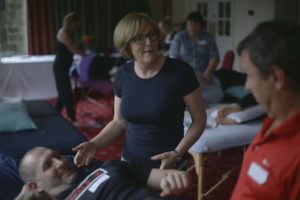A few weeks ago I had the pleasure of running a four-day workshop on the lower extremities with the Hendrickson Method.
Hendrickson Method.
It was a wonderful few days of sharing ideas and developing techniques, and I love how these workshops are especially thought provoking for me as the teacher. I hear all sorts of insightful questions and discussions, and I would like to share one topic in particular, which I have since reflected on greatly: shedding light on SI joint dysfunction.
In Massage World recently there was an article by John Gibbons http://www.johngibbonsbodymaster.co.uk/training/articles/) on this topic, titled ‘Body Master’, a well written and informative article which led me to think more on assessment protocol, for SI joint dysfunction.
Assessment protocol has been a divisive topic over the years, covered by many different accepted and rejected books, which respectively has helped me develop the fundamentals of good assessment. However, I have found in clinic that for 80% of the people I treat this basic protocol is beyond them, and not enough to understand the full extent of a complex problem. For patients with ME, chronic pain, and chronic fatigue syndrome or disc issues basic assessment techniques intimidate the patients, and I question how much information we even gather from this as a result.
So, my four key tools to discover the source of the problem:
1.) Begin by knowing that the subjective assessment has to be lengthy. This allows us to create an accurate whole picture, as most of our patients with LBP present with an acute episode which is coupled with a chronic condition.
2.) Have the patient standing fully clothed, (allowing them to feel comfortable and at ease) preferable in loose clothing, in order to accurately assess posture. Look for how the patient stands, pronation or supination, tight short v long weak. Is there an anterior or posterior tilt? Do they have rounded shoulders?? Observe how the clothes are hanging, all giving us information we need to build a picture that can tell us were the imbalance begins, to create the pain/dysfunction at the Si joint.
3.) Palpate to feel the tension within the muscles, carefully feeling and tracing lines of tension and dysfunction.
4.) Use MET (muscle energy techniques) to gently assess firing quality.
The important thing to remember is that if our anatomy is solid, we will always then be able to understand the impact of muscles working reciprocally around the body. Exploring and understanding all the muscles which attach above and below the pelvis, gently checking for function, will tell us the imbalance which would lead the SI joint being restricted or give us the source of acute pain.
SI joint discomfort is at the end of the day only a messenger, letting us know when an imbalance is occurring which needs to be addressed.
Hope this is helpful
